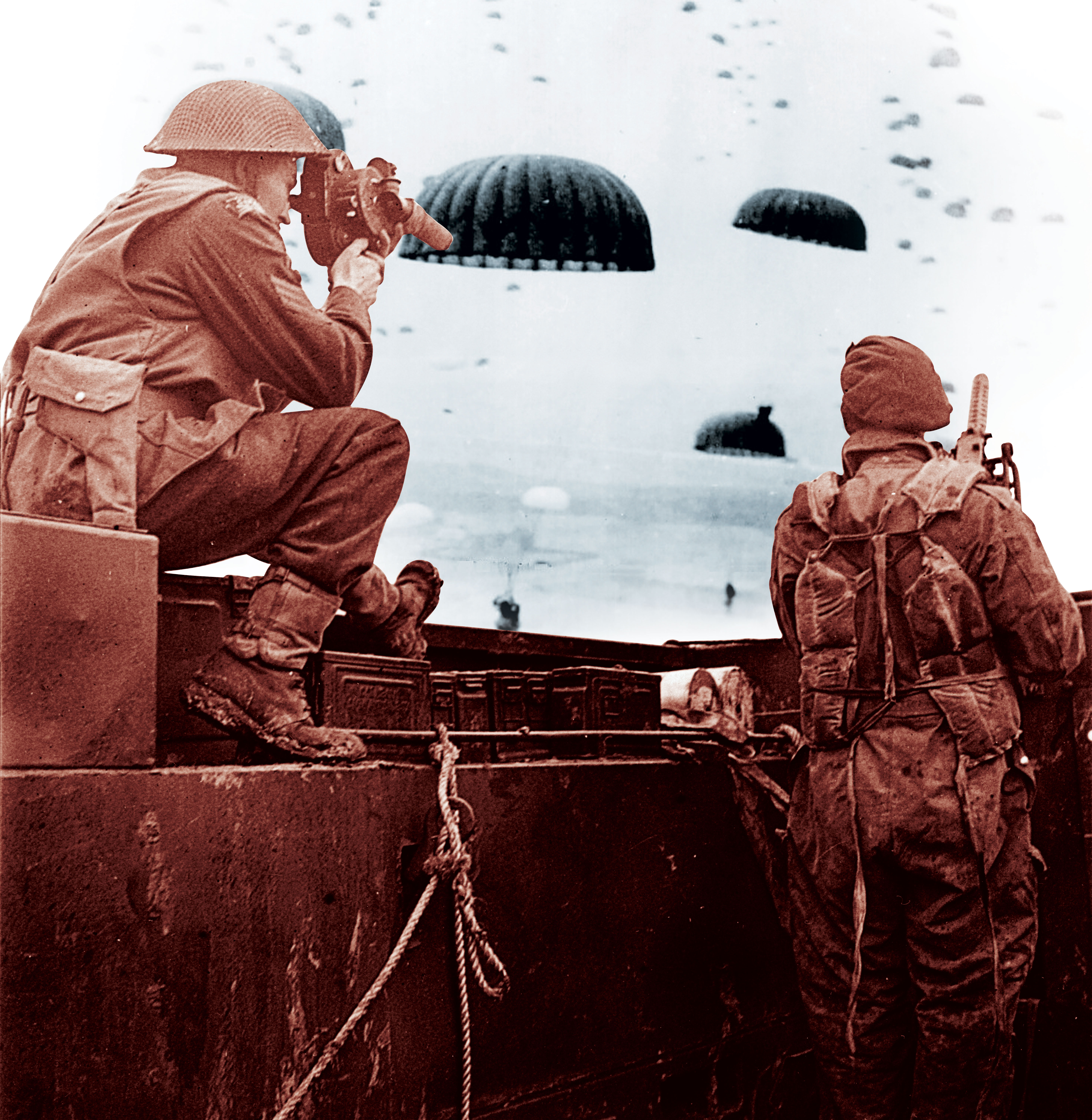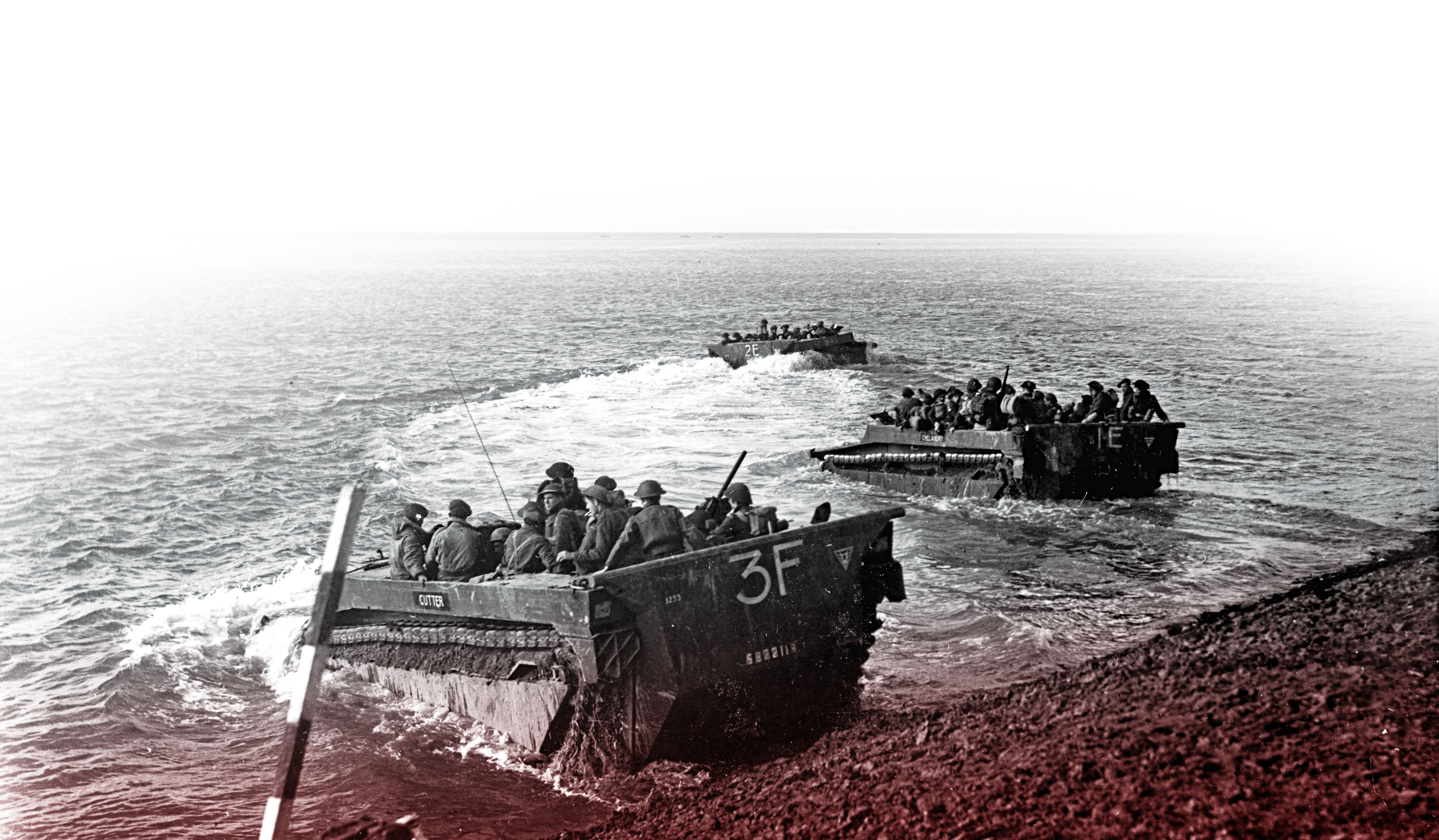
Combined: Sergeant Hugh McCaughey of the Army Film and Photo Unit captures the advance of the North Shore (N.B.) Regiment across the Scheldt River on Oct. 11, 1944. Waves of paratroopers land in the Netherlands during operations by the 1st Allied Airborne Army in September 1944. [Donald I. Grant/DND/LAC/PA-137227; Wikimedia]

Britain’s XXX Corps closed in on Antwerp on Aug. 30, 1944, General Bernard Montgomery decided it was unnecessary to open the Belgian city’s massive port to Allied shipping. So, despite the liberation of the city on Sept. 2, no advance north of the Albert Canal was attempted. This left the 80-kilometre estuary—at the tidal mouth of the Scheldt River connecting the city to the North Sea—in German hands.
Newly promoted to field marshal, Montgomery instead turned XXX Corps eastward for Operation Market Garden—a push into German territory designed to seize a foothold over the Rhine River and create an Allied invasion route into northern Germany—the rapier thrust Montgomery believed could win the war. The Allies’ need for a channel port was urgent, but he thought just one French harbour would suffice to supply Market Garden.
“I continued to plan the concentration of such resources as I had into a drive that would hustle the enemy straight through to that river; in order to jump it quickly before the Germans could seriously oppose us,” Montgomery wrote. For “this reason I considered it worthwhile to employ all our resources for its accomplishment at the expense of any other undertaking.”
Initially, General Dwight D. Eisenhower, Supreme Commander of the Allied Expeditionary Force, instructed Montgomery to prioritize opening Antwerp, but he ignored him. Eventually, Montgomery assigned the task to First Canadian Army. But he dispersed its strength by directing 2nd and 3rd Canadian Infantry divisions and I British Corps to first seize the channel ports of Le Havre, Boulogne, Calais and Dunkirk.
During a meeting in Brussels on Sept. 10, Eisenhower reversed his position and agreed that clearing the Scheldt estuary could be postponed. Listening to Montgomery describe the invasion of airborne troops through which XXX Corps would race to win a Rhine crossing at Arnhem for a springboard into Germany, Eisenhower decided to gamble on Market Garden’s success.
“I not only approved it. I insisted on it,” Eisenhower said in 1966. “What we needed was a bridgehead over the Rhine. If that could be accomplished, I was quite willing to wait on all other operations.”
Even before this meeting, the opportunity to easily open the Scheldt had passed. On the night of Sept. 7-8, 25,000 men, 350 vehicles and 50 tonnes of equipment of the German 15th Army fleeing north from Normandy were ferried across the estuary. Subsequently, as each night saw more Germans ferried to the north shore, return trips transferred 70th Infantry Division to defend the estuary’s south side.
By Sept. 13, the Germans were entrenched behind the Leopold Canal on the edge of the Breskens Pocket, an area of fortified German resistance on the south shore of the estuary. North of Antwerp, more Germans stood behind a line running from the Albert Canal to prevent any advance from the city into the South Beveland peninsula and Walcheren Island.
As the Germans hardened their positions on the Leopold Canal, 4th Canadian Armoured Division arrived opposite on Sept. 12 to force a crossing at Moerkerke, where the Leopold is paralleled by the Schipdonk Canal. Once the Algonquin Regiment bridged both canals, the rest of the division was to funnel through to clear the Leopold’s north bank while also dashing northeastward to reach the coast at the Scheldt’s mouth. That would end the German ferry operation there and isolate most of the 15th Army south of the estuary.
German machine guns and artillery lashed out when the Algonquins began launching assault boats shortly before midnight on Sept. 13. Despite heavy casualties, the regiment crossed and secured a small bridgehead near Molentje. Fierce counterattacks through the morning of Sept. 14 prevented them from reinforcing the bridgehead. At noon, the surviving Algonquins escaped across the canals under cover of a terrific barrage of smoke and high explosives fired by Canada’s 15th Field Artillery Regiment. Canadian casualties totalled 153, of which 29 died and 66 were taken prisoner.
This defeat convinced First Canadian Army’s Lieutenant-General Harry Crerar that the “capture of Walcheren and Beveland islands” would be a “very tough proposition…and to require a lot of ‘doing.’”
By Sept. 16, 3rd Canadian Infantry Division and I British Corps were still busy clearing the channel ports, but Crerar sent 2nd Canadian Infantry Division toward Antwerp. Attempts to open the Scheldt would proceed in piecemeal fashion.
Market Garden launched on Sept. 17. Ten days later, Montgomery and Eisenhower conceded their calculated risk had failed. Some 2,800 British paratroops had to be evacuated from Arnhem. Eisenhower demanded that Antwerp now be opened without delay. The shift of British Second Army eastward to support Market Garden, however, had forced Crerar to rush I British Corps—having just won Le Havre on the French coast—to fill the gap between the two armies. This left that corps unable to support opening the Scheldt.
On Sept. 24, an attempt to cross the Antwerp-Turnhout Canal northeast of Antwerp did not go well. Sixth Canadian Infantry Brigade, badly depleted by earlier fighting, had received a large number of barely trained reinforcements. The attack quickly crumbled with heavy casualties suffered. Sending those “poor devils” into battle “was a crime,” said Lieutenant Cecil Law of the South Saskatchewan Regiment. “I wept over some of those poor kids.”
Crerar was hospitalized for dysentery and a possible blood disorder on Sept. 25, and command passed to Lt.-Gen. Guy Simonds of II Canadian Corps. Simonds’ army command debut entailed waging the most complex operation First Canadian Army had faced, providing the ambitious general an opportunity to demonstrate his strategic and tactical skill.
Simonds outlined his plan on Sept. 27. Advancing from Antwerp, 2nd Division would cut off the South Beveland peninsula while 4th Armoured Division would establish a blocking position to the east around Bergen op Zoom. Just west of this medieval city, South Beveland was linked to the mainland by a narrow isthmus. Having captured Calais, 3rd Division would clear the Breskens Pocket.
As a finishing touch, aerial bombardments would breach Walcheren’s dikes to inundate much of the island shortly before an amphibious invasion. Flooding Walcheren meant inevitable destruction of property and loss of livestock for its Dutch residents. Only Eisenhower could authorize such a step. Anxious to get Antwerp open, Eisenhower approved Walcheren’s flooding on Oct. 1.
The same day Eisenhower sealed Walcheren’s fate, 5th Canadian Infantry Brigade secured a firm bridgehead across the Antwerp-Turnhout Canal. By day’s end, the engineers had installed bridges. The way was now open for 6th Canadian Infantry Brigade to drive the Germans off the rest of the canal and link up with an advance by 4th Canadian Infantry Brigade from Antwerp.
In heavy fighting on Oct. 2, 4th Brigade cleared Merksem—a port town that sprawled for two kilometres along the Albert Canal’s north bank. The following day, 4th Brigade’s Royal Hamilton Light Infantry assaulted a strong German line amid a major railroad marshalling yard near Antwerp.
To crack the German defence, Lt.-Col. Denis Whitaker—a former Hamilton Tigers quarterback—smothered the position with artillery, anti-tank gun and Vickers machine-gun fire. Running behind a creeping barrage, Major Joe Pigott’s ‘C’ Company overran each strongpoint seconds after the shells lifted to move to the next 100-metre marking point. ‘C’ Company had four men killed and 21 wounded, but they killed or wounded 30 Germans and took 80 prisoners.

Buffalo amphibious vehicles take troops across the Scheldt Estuary. [DND/LAC/PA-145567]
Two days later, 4th and 6th brigades linked up at Kapellen. With 4th Brigade’s left shoulder anchored on the Scheldt River, 2nd Division moved toward the South Beveland isthmus.
On Oct. 6, the division crossed from Belgium into Holland at Putte, entering the Brabant region—the nation’s highest ground (at about 20 metres) and an interwoven mix of dunes, heaths, woods, shallow marshes, small lakes and pockets of farm fields. Where dense woods bordered the road, the Germans felled trees to create barriers protecting anti-tank guns and machine guns. It took two days to come up alongside the entrance to South Beveland.
At sea level, the terrain was typical southern Holland polder: flat farmland segmented into sections by low dikes. From behind the dikes, the Germans could interdict any movement in the fields or along the dikes. Deliberate flooding had transformed most fields into muddy morasses.
While 5th Brigade’s Calgary Highlanders and Black Watch battled for Hoogerheide, 4th Brigade’s Royal Regiment fought to enter South Beveland. Facing determined resistance by paratroopers, the advance on both fronts was slow and costly. On Oct. 11, the Germans fell back to a raised railway connecting South Beveland to the mainland and into Woensdrecht, a village on an overlooking ridge. Here, 2nd Division paused to regroup.
There were two significant developments elsewhere while 2nd Division was busy advancing from Antwerp. On Oct. 2, the Allies dropped leaflets across Walcheren warning its populace to find a “safe place” away from all “roads, canals, transport lines, power stations, railway yards or sheds, warehouses and depots, enemy concentrations of all kinds.”
A quarter of the island’s 100,000 residents lived in Middelburg and a further 25,000 had fled there after September bombing raids targeted the island’s powerful German coastal batteries. Despite the warnings, many civilians were unable to move and the breaching of the dikes was not expected.
More than 250 Lancaster bombers struck the Westkapelle dike with 1,262 tonnes of bombs on Oct. 3. Although the dike at the island’s northeastern tip was the target, the town was savaged and about 160 civilians were killed. London’s Daily Herald reported on the raid on Oct. 4 with the headline RAF SINKS DUTCH ISLAND TO SILENCE NAZI GUNS.
Breaching more sections of outer dikes left 80 per cent of the island flooded. German strongpoints and batteries were isolated from each other—precisely the result Simonds wanted.
Meanwhile, 3rd Division’s 7th Canadian Infantry Brigade had reached the Breskens Pocket on Oct. 4 and attacked the Leopold Canal near Maldegem. This was the first phase of Operation Switchback, intended to hit the Germans so hard on multiple fronts that their forces could never concentrate.
Once 7th Brigade created a bridgehead across the canal almost four kilometres deep, 8th Canadian Infantry Brigade would advance northwest to Sluis. Seventh Brigade would then drive to the Bruges-Sluis Canal. On an entirely different front, 9th Canadian Infantry Brigade would launch an amphibious assault from Terneuzen across the mouth of the Braakman Inlet. Landing at Hoofdplaat, the brigade would catch the Germans from behind and push straight along the Scheldt coast to Breskens.

The 7th Brigade attack was supported by 27 Wasps (Universal Carriers equipped with flamethrowers). With the Wasps illuminating the sky in a scarlet glow, the Canadian Scottish and Regina Rifles struck at dawn on Oct. 6. As the Wasps ceased flaming, the Canadian Scottish scrambled into assault boats and quickly gained the opposite shore. Heavy machine-gun fire, however, shredded many of the canvas watercraft carrying the Reginas’ ‘D’ Company. A Royal Montreal Regiment company was swapped in to gain battle experience.
Two platoons were slaughtered on the water, while a third crossed unscathed. As this platoon advanced, it was counterattacked and overwhelmed and the survivors were taken prisoner. What remained of the Royal Montreals and ‘D’ Company clung to the far bank, hoping for reinforcement.
The Canadian Scottish to the right established a better bridgehead, but counterattacks threatened its survival. When the Royal Winnipeg Regiment was fed in on Oct. 7, its attack faltered. Adding to the peril, German coastal guns firing from 16 kilometres away pounded the position. With no chance of forward gains, 8th Brigade was held back. The bridgehead’s fate rested on 9th Brigade’s amphibious attack drawing off German strength.
Twice postponed, 9th Brigade’s North Nova Scotia Highlanders and Highland Light Infantry (HLI) moved in Buffalo tracked amphibious landing craft to Hoofdplaat early in the morning on Oct. 9. Achieving complete surprise, they quickly secured the beach. As the two regiments advanced, resistance strengthened.
“Fighting took the form of attacking from one dike to the next,” the HLI regimental historian recorded. The North Novas reported that the Germans fought “to the last ditch of the dirty, muddy country, asking no quarter and giving none…. It had to be instead a slow slugging…. It was cold and wet…. There was continuous shelling and mortaring and conditions were horrible.”
In the Leopold Canal bridgehead, 9th Brigade’s success opened the way for a slow, costly advance by 7th Brigade. On Oct. 13, the bridgehead was declared secure. But instead of moving through the Leopold bridgehead, 8th Brigade joined 9th Brigade, taking over its left flank. By Oct. 15, both brigades were deep into the Breskens Pocket.
The Black Watch tried to cut off the South Beveland isthmus in the Woensdrecht sector on Friday, Oct. 13. As the lead companies slogged across muddy fields, German paratroops lashed out from the raised railway. Black Watch Lieut. W.J. Shea reported that the “companies are being annihilated.”
The reserve companies were committed and similarly cut to pieces. The regiment withdrew at 1 a.m. on Oct. 14. The Black Watch counted 56 dead, 62 wounded and 27 taken prisoner, on a day thereafter known as Black Friday.
The Royal Hamilton Light Infantry entered Woensdrecht on Oct. 16 after a divisional regrouping. The Rileys fought for six days until relieved by the Queen’s Own Cameron Highlanders—a relief made possible only by 4th Armoured Division having taken over some of 2nd Division’s responsibility to the east.
Now 2nd Division could exchange piecemeal operations for a cohesive strategy. It concentrated on breaking into South Beveland. At the same time, 4th Armoured Division approached Bergen op Zoom to seal off the Germans defending the Scheldt.
The isthmus was narrowest—barely 1,500 metres wide—where it joined the mainland. The attack was launched on the “cold, clear, moonless night” of Oct. 25. The Essex Scottish war diarist recorded that by 6 a.m. “the tough shell of the defences at the narrowest point…had been broken.”
As 4th Brigade entered South Beveland, the German defenders began to break. While never quite turning into a rout, 2nd Division would remember this advance as the South Beveland Race—one that brought it to Walcheren Causeway on Oct. 30.
Closing on Bergen op Zoom, meanwhile, had proven a tough task. By Oct. 27, however, it appeared the Germans were withdrawing. The city centre was a maze of ancient, narrow streets, so any street fighting would prove deadly.
The Canadians found the city abandoned. On the northern outskirts, however, the Zoom Canal provided a good German defensive position that was held until Oct. 30,
costing 10th Canadian Infantry Brigade heavy casualties to win.
By the end of October, the Germans defending the Breskens Pocket were in dire straits. Steadily and remorselessly, 8th and 9th brigades had pushed westward. Breskens, at the mouth of the Scheldt River, fell on Oct. 22. A general surrender came on Nov. 1. Third Division’s casualties totalled 2,077, but it had taken almost 13,000 prisoners.
The Scheldt’s south bank was now clear, but Walcheren still prevented the estuary from opening. On Oct. 31, the Black Watch attempted to win the causeway linking South Beveland to the island.
It was a perfectly engineered killing ground—1.2 kilometres long by 40 metres wide and gun-barrel straight. Lt.-Col. Bill Megill considered it “monstrous” to commit his badly battered regiment to this attack. Two companies were quickly pinned on the causeway. Unable to dig in because of its mixed surface of bricks and rock, there was no cover.
Virtually without pause, the Calgary Highlanders went forward. It was another clear, cold night as ‘B’ Company led off. Its 100 men suffered heavy casualties and were pinned down. Major Bruce MacKenzie’s ‘D’ Company led a new attack. “Come on, you sons-of-bitches,” he yelled and ‘D’ Company charged through to Walcheren, but the Calgaries were soon forced back 300 metres onto the causeway.
Régiment de Maisonneuve was next and won some ground, but there was no hope of expanding it. With 2nd Division obviously spent; the British Glasgow Highlanders took over.
The fate of Walcheren was sealed, however. On Nov. 1, the British 4th Special Service Brigade launched two amphibious assaults—one at Vlissingen and the other at Westkapelle. Driven from most coastal positions on Nov. 2, some 2,000 Germans withdrew inland to Middelburg, where they surrendered four days later.
First Canadian Army’s victory came at a terrible price. From Oct. 1 to Nov. 8, almost 13,000 had been killed, wounded or gone missing. Half were Canadians.
The port welcomed its first 18-ship convoy on Nov. 28. No Canadians were present, but one ship was the Canadian-built SS Fort Cataraqui.
Advertisement






















